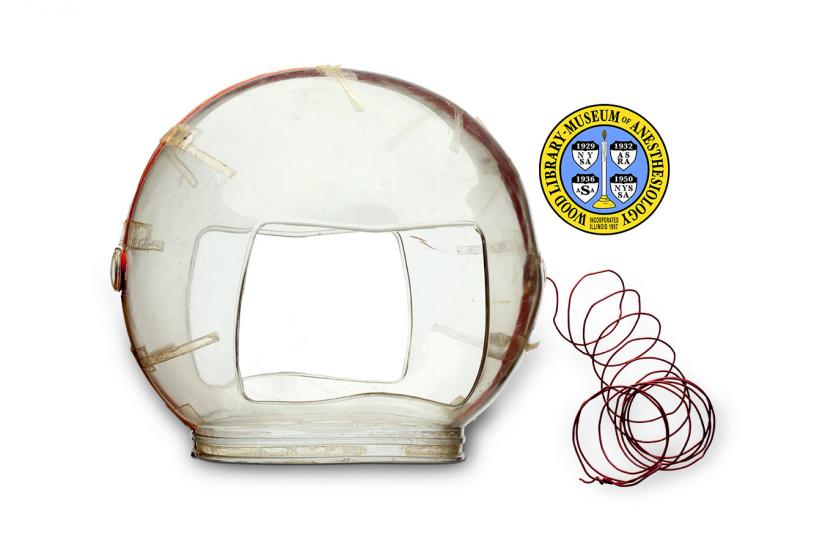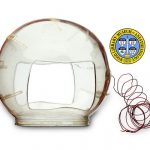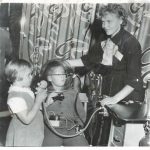Toy Space Helmet
This helmet was originally marketed to fans of the children’s television show, Space Patrol, in the early 1950s. It is open in the back as well as the front, to avoid the possibility of suffocation. The popularity of space adventure shows, together with this safety feature, made it an appealing tool for pediatric surgery. Children could be difficult patients of inhalation anesthesia, panicking when the mask was applied. Several anesthesiologists used modified space helmets and other toys to make it a less frightening experience. Dr. Harry M. Slater (1915-1993) used this helmet for his pediatric patients.
In 1955, Dr. Tiina Bougas, then a specialist at Children's Medical Center in Boston, showed how the space helmet and a rubber squeeze toy could be used in operating rooms by children to unknowingly inhale the anesthetics.
Catalog Record: Space Helmet
Access Key: akog
Accession No.: 2011-04-18-1 A
Title: [Space-helmet inhaler / Harry Slater.]
Author: Slater, Harry M., 1915-1993.
Title variation: Alt Title
Title: Space helmet for pediatric anesthesia.
Publisher: [Place of manufacture not indicated] : [Name of manufacturer not indicated],
[1950-1960].
Physical Descript: 1 toy helmet ; plastics, rubber, textiles, wire ; 32.5 x 39.5 x 28 cm.
Subject: Anesthesia, Pediatric.
Subject: Anesthesia, Inhalation.
Subject: Inhalers, Anesthesia.
Note Type: General
Notes: This helmet matches a plastic toy helmet made by Beemak Plastics of Los
Angeles, and sold under the name, “Space Patrol Outer Space Plastic Helmet”.
The date range for the possible year of manufacture is based around the dates
that the television and radio shows “Space Patrol” ran, 1950 to 1955. The
date range could change if new documentation that indicates that the dates
should be corrected.
Note Type: General
Notes: The title is based on the caption of an image of Dr. Slater next to his
younger brother who models the use of the helmet for inhalation anesthesia.
The image is from a 2003 publication of the Canadian Anesthesiologists’
Society written by Shephard, Chalklin and Pope. The title could change if new
documentation that indicates that the dates should be corrected.
Note Type: Citation
Notes: Bassior JN. Space Patrol: Missions of Daring in the Name of Early Television.
Jefferson, N.C.: McFarland & Co.; 2005:1,205,366.
Note Type: Citation
Notes: Conn AW. Origins of paediatric anaesthesia in Canada. Pediatr Anesth.
September 1992;2(3):179-189.
Note Type: Citation
Notes: Cross G. Play, games, and toys. In: Fass PS, ed. The Routledge History of
Childhood in the Western World. New York: Routledge; 2013:278-279.
Note Type: Citation
Notes: Giorgio DJ, Morrow JG, inventors. Anesthetic feeder for children in the form
of a space helmet. US patent 2,742,900. April 24, 1956.
Note Type: Citation
Notes: Giorgio DJ, Niiranen JV, Morrow JG. “Space helmet” induction of pediatric
anesthesia. US Navy Med News Lett. 1954;23(5):12-13.
Note Type: Citation
Notes: Giorgio DJ, Niiranen JV, Morrow JG. The use of a “space helmet” for the
induction of pediatric anesthesia. Anesthesiology. March 1955;16(2):290-294.
Note Type: Citation
Notes: Miller CJ, Van Riper AB. 1950’s “Rocketman” TV Series and Their Fans: Cadets,
Rangers, and Junior Space Men. New York: Palgrave Macmillan; 2012:47.
Note Type: Citation
Notes: Roman JW. From Daytime to Primetime: The History of American Television
Programs. Westport, Conn.: Greenwood Press; 2005:1-16, 47.
Note Type: Citation
Notes: Shephard DAE, Chalklin J, Pope F. An exhibit of inhalers and vaporizers,
1847-1968: Illustrating aspects of the evolution of inhalation anesthesia and
analgesia from ether to methoxyflurane: artifacts from the Canadian
Anesthesiologists’ Society Archives. Canadian Anesthesiologists’ Society
website. https://www.cas.ca/English/Page/Files/74_Exhibit%20of%20Inhalers.pdf.
Published June, 2003. Accessed November 22, 2013.
Note Type: Citation
Notes: Shephard DAE, Turner KE. Preserving the heritage of Canadian anesthesiology:
a panorama of people, ideas, techniques and events. Canadian
Anesthesiologists’ Society website. https://www.cas.
ca/English/Page/Files/74_Preserving%20the%20Heritage.pdf. Published June,
2004. Accessed November 22, 2013.
“Space Helmet” helps overcome fears. Hosp Top. 1954;32(4):35.
Note Type: Citation
Notes: Space Patrol outer space helmet. The Spaceman’s Toy Chest blog.
https://spacemanstoychest.blogspot.com/2011/01/space-patrol-commander-helmet.
html January 31, 2011. Accessed November 25, 2013.
Note Type: Physical Description
Notes: One clear plastic helmet with rectangular openings in the front and back; The
helmet is formed from two halves and held together with red and clear tape;
The tape is quite fragile and the helmet must e handled with care; The helmet
is not accompanied by an inflatable neck piece and ‘oxygen tank’ that the toy
product was sold with; A spiral ‘antenna’ has been formed from red plastic
covered wire, and can be attached to round extensions on each side of the
helmet; With the ‘antenna’ in place the helmet measures 32.5 x 39.5 x 28 cm.;
The helmet alone measures 26.5 x 30.5 x 28 cm.; In the records box in which
the helmet is held are two red rubber ‘goggles’ with velcro straps; The
rubber and a sponge like material of the goggles covers the eyes; No
manufacturer’s marks are found on the helmet.
Note Type: Reproduction
Notes: Photographed by Mr. Steve Donisch, June 11, 2013.
Note Type: Acquisition
Notes: Donated to the WLM by Dr. Harry M.Slater. Donation facilitated by Dr. C.
Ronald Stephen.
Note Type: Historical
Notes: Dr. Harry M. Slater used this ‘space helmet’ to ease the anxiety of children
before surgery. It also allowed children to actively participate in the
induction (or beginning) of anesthesia.
Space stories told in radio programs and comic strips of the 1930s and ‘40s,
and in television shows of the ‘50s and ‘60s, were very popular with children
Buck Rogers, Flash Gordon, Captain Video, Space Patrol, and Space Cadet are
just a few of the comics and programs that captured the imagination of young,
enthralled fans. Many of these fans were more than happy to role-play a trip
into space. With the helmet on, children were handed a mask to breathe
through. The mask fit through the large opening in the helmet and delivered
anesthetic gases as well as oxygen.
Dr. Slater, of Montreal Canada, specialized in pediatric anesthesia, and is
also known for developing a nonrebreathing valve with Dr. C. Ronald Stephen.
His space helmet may have been modified from a toy product, and was not the
only helmet used for the administration of anesthesia. Commercial production
of a “Space Helmet” designed by anesthesiologists Dr. D. J. Giorgio and J. G.
Morrow began in 1954. This device was manufactured by Rogay Industrial and
Commercial Models of Washington, D.C.
Note Type: Publication
Notes: Smith RA. Techniques for the induction of general anesthesia. In: Anesthesia
for Infants and Children. St. Louis: Mosby; 1959:143.
Note Type: Publication
Notes: Tafler D. Dental symposium advised on how to revive patients. Montreal
Gazette. October 29, 1964:A1.
Note Type: Exhibition
Notes: Chosen for the WLM website (noted November 4, 2013).




